China
Template:Infobox State/Maintenance/TRANSCRIPTION
Template:Infobox State/Maintenance/NAME-German
The People's Republic of China (Chinese 中华人民共和国, pinyin Zhōnghuá Rénmín Gònghéguó [![]()
![]() tʂʊŋ˥xua˧˥ʐɛn˧˥mɪn˧˥kʊŋ˥˩xə˧˥kuɔ˧˥]), commonly referred to as China, is a country in East Asia. With a population of more than 1.4 billion (2020), China represents the most populous country in the world and the third largest in terms of total land area. According to its socialist constitution, the People's Republic of China is "under the democratic dictatorship of the people", but from the beginning it has been consistently ruled in an authoritarian to totalitarian manner solely by the Chinese Communist Party (CCP). To this day, it is accused of serious human rights violations.
tʂʊŋ˥xua˧˥ʐɛn˧˥mɪn˧˥kʊŋ˥˩xə˧˥kuɔ˧˥]), commonly referred to as China, is a country in East Asia. With a population of more than 1.4 billion (2020), China represents the most populous country in the world and the third largest in terms of total land area. According to its socialist constitution, the People's Republic of China is "under the democratic dictatorship of the people", but from the beginning it has been consistently ruled in an authoritarian to totalitarian manner solely by the Chinese Communist Party (CCP). To this day, it is accused of serious human rights violations.
The People's Republic was proclaimed by Mao Zedong on October 1, 1949, after the fall of the Republic of China in the Chinese Civil War. It is estimated that 45 million people died in the famine caused by the "Great Leap Forward" (1958-1961) initiated by Mao, and up to 20 million more died in the subsequent Cultural Revolution from 1966. It was only after Mao's death that China developed into a major economic and technological power on the basis of a cautious reform and opening-up policy from 1978 onwards. Since 2016, the World Bank has ranked the country among the countries with an income level in the upper middle range. On average, China's economic power grew by 8.9% annually from 2000 to 2019 inclusive. In addition to doubling China's share of global trade, its gross domestic product increased sixfold during that period, so that by the end of that period China had grown to become the world's second-largest economy. Since the assumption of power by Supreme Leader Xi Jinping in 2012, however, the People's Republic has, according to observers, once again taken steps backwards in terms of social and economic freedom and is becoming increasingly ideological and internationally aggressive.
The People's Republic of China is one of the official nuclear powers, a permanent member of the World Security Council and a member of the World Trade Organization, World Bank, APEC, BRICS, UNESCO, Interpol, G20, among others.
Geography
China is the fourth largest country in the world by total area (land and water) at 9,596,960 km² and the third largest country by land area at 9,326,410 km². The territory stretches from the northernmost tip on the Siberian border to the southern tip of Hainan Island for about 5,500 kilometers and from east to west for about 5,200 kilometers. To the east and southeast, the national territory borders the Yellow Sea as well as the East China Sea and the South China Sea. In the south, southwest, west and northwest high mountain ranges, in the north steppes and deserts, in the northeast the Amur and the Ussuri separate the country from its neighbors.
China has the longest land border of any country, with a total length of 22,133 kilometers. The coastal length of all maritime borders is 14,500 kilometers. In total, the People's Republic of China has 14 neighboring countries. These are counterclockwise: North Korea in the northeast, then Russia and Mongolia, westward follow Kazakhstan, Kyrgyzstan, Tajikistan, Afghanistan and Pakistan, southward and southwestward follow India, Nepal and Bhutan, finally Myanmar, Laos and Vietnam.
The physical surface, the climatic conditions and thus the habitability of the individual regions differ greatly. The land slopes from west to east. The topographical features can be divided into five forms, whose respective proportions of the total area of the mainland are as follows: Mountains (33.3%), plateaus (26%), basins (18.8%), plains (12%), and hill country (9.9%).
Western China has a distinct high mountain character with intervening plateaus. The highest mountains are: Himalaya, Tian Shan, Pamir, Altai. To the east are plateaus and sedimentary basins, such as the Mongolian Plateau, the Tarim Basin, the Sichuan Basin, and the Yunnan-Guizhou Plateau. Xinjiang and Inner Mongolia are the driest parts of the country, with the Gobi and Taklamakan representing their distinct desert climates. Eastern China is characterized by four large alluvial plains. On the coasts there are huge river deltas. The southeastern coastal strip is mountainous, while the south is more hilly.
There are about 5,400 islands scattered in the territorial waters. In accordance with the claim to sole representation granted by the UN, the People's Republic of China considers Taiwan to be the largest island with an area of 36,000 square kilometers, and Hainan the second largest with an area of 34,000 square kilometers. Of the 14 mountains higher than 8000 meters, nine are located on the Chinese border or within China. Most of China's high mountains rise from the high mountains south of the Qinghai-Tibet Plateau, the roof of the world. The Himalayan range averages 6000 meters above sea level. The highest mountain in China is Qomolangma (Mount Everest), which is located on the border with Nepal. With a height of 8,844.43 meters, it is also the highest mountain in the world.
The Yangtze River (Yangtze for short) is the longest river in China, with a total length of 6,300 kilometres, and the third longest river in the world after the Nile and Amazon. The Yellow River (Huang He) is the second longest river in China; its total length is 5,464 kilometers. Other major rivers include the Xi Jiang, the Mekong, the Pearl River and the Heilong Jiang. The rivers flow according to the geographical conditions from west to east: from the high regions with snow and glaciers to the plains to the coasts.
The largest canyon in China is formed by the Dihang Gorges of the Yarlung Tsangpo in the Tibetan highlands. With a length of 504.6 kilometers and a depth of up to 6,009 meters, the narrow gorge is considered the largest in the world. Its deepest point is -154 meters in the dried-up Aydingkol Lake in the Turpan Depression in eastern Xinjiang.
Poyang Lake, located in the plain on the middle and lower reaches of the Yangtze River, is the largest freshwater lake in China. Its area is 3,583 square kilometers. The largest salt lake is Qinghai Lake on the Qinghai-Tibet Plateau, with an area of 4,583 square kilometers. The largest canal is the Imperial Canal. It begins in Beijing in the north and ends in Hangzhou in the south. Its total length is 1,801 kilometers. Construction began in the 5th century BC - it is the longest and oldest man-made waterway in the world.
See also: List of lakes in China, List of Chinese seas and List of Chinese deserts
Climate
→ Main article: Climate in China
The climate in China is as diverse as the geography, with 18 different climate zones. Continental climate is found in the northeast. Winter is long, very cold and dry, but often sunny. Summer, on the other hand, is warm and humid because it is influenced by the summer monsoon. Then it can get muggy-warm with 30 °C and high humidity.
Dry desert climate extends from the Taklamakan in the west to Beijing. It is characterized by frosty winters with little snow and hot summers. In addition, there is extreme drought and large diurnal temperature fluctuations. The high mountains in the interior of China have a cool mountain climate with high temperature contrasts. Winters are extremely cold, but the sun shines almost continuously during the day. In summer it gets moderately warm and there is occasional rain.
In the east between Beijing and the Yangtze, there is a temperate monsoon climate. There are consistently cool, partly frosty, mostly dry and snow-poor winters. The sun appears frequently at this time of year. In summer it becomes increasingly hot. The summer monsoon brings not only abundant rain, but often an oppressive sultriness. The climate in the east south of the Yangtze is subtropical, in the extreme south tropical. Winters are mild to warm and rather dry. In summer it becomes tropical-hot with heavy rainfall and high temperatures. Also at night it hardly gets cooler.
Precipitation increases steadily from west to east and from north to south. In the deserts of central China, hardly 100 milliliters of rain fall annually; the wettest region is southeast China, with up to 3000 mm. In all regions, almost all precipitation falls in the summer months. On this basis, China's land area consists of 36% fertile farmland, 24% grassland, 9% forest and 2% wetland, and 21% desert and 6.5% wasteland. Cities occupy 1.5% of the total land area in China.
Flora
Much of China's natural vegetation has been replaced or altered by thousands of years of human settlement, but individual areas give room for great biodiversity, so China has one of the richest and most diverse assemblages of plants and animals in the world. Virtually every major plant in the tropical and temperate zones of the Northern Hemisphere is found there. In all, more than 7,000 species of woody plants have been recorded, of which there are 2,800 woody trees and over 300 species of gymnosperms. The rare ginkgo tree, the pigeon tree (conifer) and the primeval sequoia, long extinct elsewhere, still grow in China. Among flowering plants, 650 of the 800 known species of azalea are found in China, while 390 of the 450 known varieties of primrose and about 230 of the 400 known varieties of gentian are found there. The peony, which originates from Shandong Province, is found in 400 varieties.
The richest and most extensive coniferous forests occur in the mountains of the northeast, where stands of larch, Asian white birch, and Scotch pine thrive, and stands of Korean pine and Dahurian larch. In the Sichuan Basin, vegetation changes with elevation, so that a variety of conifers grow at high elevations, deciduous trees and cypresses at middle elevations, and bamboo at lower elevations. Further south, in the subtropical provinces of Fujian and Zhejiang, evergreen deciduous forests predominate. Forests give way to natural grasslands and scrub in drier western and northwestern areas, especially in the semi-arid regions of Shanxi and Shaanxi, the steppes of Inner Mongolia, and along the desert margins of the Tarim and Junggar basins.
Fauna
The different habitats are home to a diverse fauna. This ranges from arctic species in Manchuria to a rich tropical fauna in the south. In total, there are over 6,300 vertebrates in China, including 2,469 terrestrial vertebrates with about 500 species of mammals, 1,258 species of birds, 376 species of reptiles, 345 species of amphibians and 3862 species of fish. Hundreds of thousands of invertebrate species also occur, including about 150,000 insect species.
Some species already extinct in other parts of the world have survived in China. These include the swordtail sturgeon from the Yangtze River, certain alligators and salamanders, the giant panda, which lives only in southwest China, and the water deer, which exists only in China and Korea. Other endemic and rare species include blunt-nosed monkeys, the South China tiger, four species of eared pheasants, the Manchurian crane, the Nipponibis and the China alligator.
Tropical southern China is home to a wide variety of primates, including gibbons, macaques and many other species of monkeys. Larger predators, such as bear, tiger and leopard, are present in limited numbers and are found only in remote areas. Leopards live in northern Manchuria; Tibet is the habitat of the snow leopard. Smaller predators, including fox, wolf, and raccoon, are numerous in many regions. Antelope, gazelles, chamois, wild horses, and other ungulates inhabit the mountainous regions and valleys in the west. The elk is common in northern Manchuria. Birds are found in a wide variety of species, including pheasants, cranes, parrots, herons, and Asian peacocks. Water buffaloes are among the domestic animals used as draught animals in the south, as are camels used as beasts of burden in the arid north and west, and yaks, which serve as semi-domesticated high mountain cattle in Tibet. Flounder, cod, tuna, squid, crab, shrimp, and dolphin are found especially on the southern coast. China's rivers provide habitat for several species of carp as well as salmon, trout, sturgeon and catfish. Many of China's inland waters are used for fish farming.
The panda is considered a national treasure by the Chinese. By order of China's National Forestry Administration, the provinces of Sichuan, Gansu and Shaanxi have been obliged since 2011 to conduct a census of the population living in the wild every ten years. In the last so-called panda census at the beginning of 2015, 1,864 pandas were counted, compared to only 1,596 ten years earlier. The panda breeding station in Chengdu, from where the sexually very abstinent pandas with a correspondingly low reproduction rate are released into the wild after breeding, plays a significant role in this growth.
The first nature reserves were established in the 1950s. Since then, a total of over 2,700 nature reserves have been established in China. The area of all protected areas is 1.42 million square kilometers. This corresponds to around 15 percent of the country's territory.
See also: List of nature reserves in the People's Republic of China
Natural disasters
China is regularly hit by droughts, floods, snowstorms, hail, landslides, sandstorms and wildfires. In addition, the coasts in the south and east of the country are frequently exposed to tropical cyclones and typhoons. Flooding occurs regularly along all major rivers. The last major flood disasters occurred in 1998 and 2016, during which entire regions were flooded for weeks. Both events were preceded by an El Niño.
The Yangtze River is located in the densely populated Yangtze River Delta. For centuries, this area has been plagued by floods. Causes for the floods are soil erosion, droughts as well as damming of the natural course of the river. The construction of the Three Gorges Dam was and is therefore controversial.
Tectonic quakes cause the greatest damage in the People's Republic of China. According to the China Meteorological Administration (CMA), they cause the most human casualties and the greatest economic losses each year. On average, about 20 earthquakes of magnitude 5.0 to 5.9 occur in China each year; three to four between 6.0 and 6.9; and only about every two to three years a maximum of two of magnitude 7.0 or more. Eastern China and the southern provinces and the Himalayas are particularly affected. Devastating damage was caused most recently by the 2013 Sichuan earthquake and the 2017 Jiuzhaigou earthquake, both with a magnitude of 7.0.
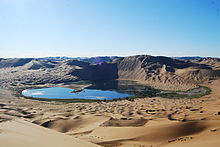
Biluthu megadune in the Badain-Jaran desert, Inner Mongolia, 2011
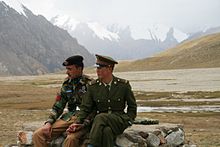
Kunjirap Pass, border between China and Pakistan, 2007
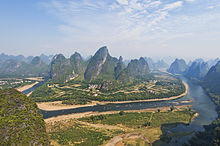
Tower karst landscape in Guilin, South China, 2011
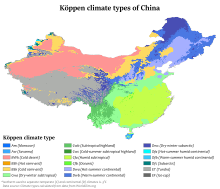
Köppen-Geiger climate classification China
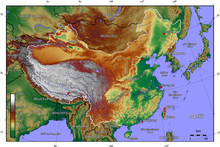
Topography of China, 2005
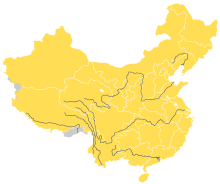
China's main rivers
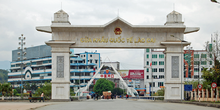
Border crossing between Vietnam and China, view from Lào Cai to Hekou, 2011
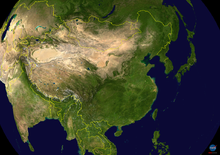
China - NASA satellite image

Dinghushan National Park, Guangdong Province, 2017

World Heritage in China: Wulingyuan rainforest with 3000 quartzite pillars on which, among others, Chinese pines grow, Hunan province, 2012
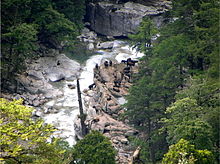
Takine in Three Parallel Rivers National Park, Yunnan Province, 2014.

Pandas in Chengdu Reserve, Sichuan Province, 2011
_National_Park,_Diqing_-_panoramio.jpg)
Wild horses in the region "South of the Clouds", Western China, 2007

Flood protection: Three Gorges Dam (left) and Gezhouba Dam (right) as seen from space (photo taken in 2000)
History
For history before the Second Opium War, see History of China.
Today's People's Republic of China is the result of a two-hundred-year process in which the Chinese Empire was replaced and China was transformed into a modern state. The dramatic events that accompanied this process still shape the country's political actors today.
End of the Empire (1911), Republic (until 1914), beginning of Yuan Shikai's dictatorship
Around 1800, China had reached its greatest expansion and economic power and produced about one third of all goods worldwide; domestically and externally, however, the Chinese empire was comparatively unstable or weak at the beginning of the 19th century. As in Europe, the population had grown rapidly, but industrialization was delayed because of China's isolation from the outside world. The available arable land per capita had declined. Hundreds of rebellions occurred; the Taiping Rebellion (1851-1864) is considered the most devastating war of the 19th century, and the great Muslim rebellions were no less savage wars. The balance of trade developed negatively after the forced opening of China. The Qing Empire had little to oppose the increasingly aggressive foreign powers, neither in the first or second Opium War, nor in the Sino-French War of 1885/86 and the Japanese-Chinese War of 1895. Large areas in northern Manchuria and East Turkestan were lost to the Russian Tsarist Empire in the Treaties of Aigun in 1858 and Beijing in 1860. These humiliating defeats were compounded by the Unequal Treaties, which led to increasing foreign domination, territorial losses, and large compensation payments to foreign states in the course of the 19th century.
Foreign pressure on China led to the self-strengthening movement, to modernizations in education and in the military, and the first Chinese began to study abroad. There were beginnings of industrialization, again largely driven by foreigners. However, the Hundred Days Reform initiated by Emperor Guangxu failed. In the "Boxer Rebellion," which was not an uprising against the government but a movement directed against the imperialist powers and which sought to prop up the Chinese government, forces were combined whose goal was the expulsion of all foreigners; this misleadingly called "uprising" of the "Boxers" (the first of whom were trained in traditional martial arts) led to war between China and the United Eight States, that is, the German Empire, France, Great Britain, Italy, Japan, Austria-Hungary, Russia, and the United States. After the suppression, the victors forced further concessions from the Imperial House in the so-called "Boxer Protocol" of 1901. It was in this environment that Sun Yat-sen's Chinese Revolutionary League was founded in Tokyo in 1905; it was to become the forerunner of the Kuomintang. It called for the establishment of a republic, an end to the Qing dynasty, a nation-state, and land reforms. In 1911, the Wuchang Rebellion broke out and the subsequent Xinhai Revolution led to Emperor Puyi's abdication of the throne. This ended the succession of several dynasties begun by Emperor Qin Shihuangdi in 221 BC. In late 1911, Sun was elected interim president of the Republic of China in Nanjing. The proclamation of the republic was met with approval, especially in the major cities. However, it was short-lived, because already in 1914 Yuan Shikai dissolved the parliament and ruled as dictator.
Republic of China Era (until 1949)
Yuan Shikai had enough military in his command to prevent China from falling apart. However, he was unable to stop the advance of foreign powers; he had the beginnings of a civil society suppressed, and the Kuomintang was banned in 1913. The country's elites therefore turned away from the state during this period and pursued their own interests. Yuan had himself proclaimed emperor on January 1, 1916, while Japan deliberately weakened him by raising the Twenty-One Demands. Control of China's politics slipped from the central government, the country fragmented, with provincial military governors and hundreds of warlords fighting for influence in shifting alliances. Chaos and misery reigned, and the population suffered oppression. Mongolia and Tibet declared their independence. However, the period of fragmentation was also a creative time, in which the intellectual climate changed through confrontation with Western thought. The May Fourth Movement became the starting point for numerous political and intellectual movements, schools and universities were founded. Capital and knowledge flowed into the treaty ports from abroad, and the basis for building the economy was laid.
After the October Revolution in Russia, there was also fascination with socialist and communist ideas in China; in 1921, the Chinese Communist Party was founded. Because China lacked industry as a basis for a proletarian movement, the Comintern supported both the Kuomintang and the Communist Party (CP). Under the First United Front, the two parties cooperated against the warlords and Japanese expansionism. With Soviet help, the Whampoa Military Academy was founded in 1924, producing many officers who were important in China's later history, such as Chiang Kai-shek and Zhou Enlai. After the death of Sun Yat-sen in 1925, tensions arose in the united front that delayed progress in the Northern Campaign. After securing Shanghai in March 1927, Chiang Kai-shek had thousands of (perceived) communists killed and a strike crushed on April 12, 1927, which broke up the united front. Chiang, who had access to the army within the Kuomintang, outmaneuvered the left wing of the party and established a counter-government in Nanjing. In June 1928, his forces succeeded in capturing Beijing, reunifying China for the time being.
The Communists, displaced to the countryside, tried to carry out uprisings in some cities and establish soviet areas. However, the uprisings in Nanchang in August 1927, Canton in December 1927, and Changsha in 1930 were crushed. Mao Zedong, on the other hand, succeeded in holding a larger area for a longer time after the Autumn Harvest Uprising with a strategy adapted to rural conditions in the mountainous areas of Hunan and Jiangxi and established a Soviet republic. Due to encirclement by Kuomintang troops, it had to be evacuated in 1934, and the CP leaders retreated with the Long March to northern Shaanxi, where they arrived a year later ideologically consolidated and unified. During this march, Mao had won the inner-party struggles and had been elected chairman of the Central Committee.
Japan, whose troops had been in northeast China since 1901 after the Boxer Rebellion, seized Manchuria from the warlord Zhang Xueliang in 1931 and established the vassal state of Manchukuo there. In 1933, Japanese troops captured Jehol. The Communists, faced with the threat from Japan, called for an alliance of all parties and armed forces. Chiang, however, preferred to first consolidate Kuomintang rule over the CP. In December 1936, Chiang had to be forced to agree to a second united front, which was then formed only after the Marco Polo Bridge incident and the open outbreak of the Second Sino-JapaneseWar. Despite the united front, Chiang deployed his most powerful troops against the CP. The united front remained correspondingly weak, compounded by the fact that Chiang's troops were weakly organized and had poor fighting morale despite support from the US and USSR. The Japanese troops thus succeeded in occupying the great plains and coastal areas of China; in Nanjing they committed mass murder lasting several weeks. However, they were unable to control the conquered areas permanently. The Chiang government had to retreat to Chongqing.
Shortly after Japan's surrender, Mao negotiated inconclusively with Chiang in Chongqing to settle their differences. The Kuomintang subsequently attempted to take control of the entire country, but its troops were undisciplined and without an understandable mandate, its representatives corrupt and feared by the population. However, parliamentary elections held in 1947 were won by the Kuomintang. The People's Liberation Army, on the other hand, had enough supporters among the population. It conquered Manchuria in 1948, Nanjing in April 1949 and Shanghai in May 1949. The Kuomintang government fled to the island of Taiwan, occupied in 1945, wiped out the elite there and established a dictatorship.
Mao Zedong Era (1949-1976)
→ Main articles: History of the People's Republic of China from 1949 to 1957 and History of China 1961-1965.
On October 1, 1949, the People's Republic of China was proclaimed. This meant the end of the national government on the mainland. The seizure of power by the CP was not an externally induced overthrow, but an upheaval supported by a broad majority. In the first phase after the proclamation of the People's Republic, a land reform was carried out from 1949 to 1952, in which almost half of the agricultural land was distributed to about 120 million peasants. "Large landowners" were expropriated. In 1950, the Communist Party passed a marriage law that supplemented the constitution by concretizing the equality of men and women. In particular, the right of women to decide for themselves whether to marry, the ban on demanding a dowry for the bride or on concubinage, the introduction of a minimum age for women, which led to the abolition of child and forced marriages, and the legalisation of the termination of a marriage through divorce with corresponding regulations on the division of property between the spouses, permanently improved the situation of Chinese women. However, breaking through the traditional rural cultural practices or teaching rural women about the law encountered obstacles that were difficult to overcome. Women's suffrage, both active and passive, was introduced in 1949.
In February 1950, Beijing signed a treaty of friendship and mutual assistance with the Soviet Union. Priority was given to the development of the urban economy, after the CP's activities during the civil war had concentrated on the rural areas. To this end, a "coalition of four" of workers, peasants, petty bourgeoisie and national bourgeoisie was formed under the slogan "new democracy". At the 8th Party Congress, Mao's values of activism, altruism, unity with the masses and consumerism did not find a majority; the path of imitating the Soviet model of development, with priority given to the development of heavy industry, was confirmed.
Mao Zedong initiated the shift away from the Soviet model with his speech on the "Ten Great Relationships" in April 1956. He initiated the Hundred Flowers Movement in May 1957 to mobilize the intelligentsia. When the call for healthy criticism also led to criticism of the party and individual party leaders, the party responded with the "Campaign Against Right-Wing Dissenters," in which 400 critics were executed and half a million people were taken to labor camps. The turn away from the Soviet Union became definitive in 1958, when the Great Leap Forward was announced. Under this campaign, almost the entire rural population was grouped into 26,000 people's communes and organized along military lines. They were to advance agriculture and heavy industry simultaneously as a "battle of production." However, planning errors, chaos and natural disasters led to some 30 million people starving to death in the three bitter years from 1960 to 1962. Liu Shaoqi took over the task of consolidating the economy from 1963 to 1964; he was criticized as a "revisionist" for his measures.
Under the pretext of revising erroneous developments and cleaning up the bureaucracy, Mao began the Cultural Revolution in the early summer of 1966. The youth was organized into Red Guards, a wave of terror began against representatives and decision-makers of the state and the intelligentsia; schools and universities remained closed, in some cases for several years. The individual was to be destroyed, the revolution was to be permanent. China closed itself even more to foreign countries. In 1968, the "up-country movement" began, with which 15 million young city dwellers were ordered to work in agriculture. State President Liu Shaoqi as well as numerous other high party functionaries were criticized as "revisionists" and removed from office. However, the Cultural Revolution period also saw the growing fear of a Soviet attack following the Sino-Soviet rift, which necessitated the normalization of relations with the United States. After a visit by President Nixon in 1972, Beijing established diplomatic relations with Washington; Beijing also took over Taiwan's seat at the United Nations. The Cultural Revolution ended after Mao's death in September 1976 and the arrest of the "Gang of Four" in October 1976.
Reform and opening (1976/1980 to 1999)
→ Main articles: History of the People's Republic of China from Mao's death to 1981 and Reform and opening-up policy.
By the time Mao died, his designated successors were already dead: Lin Biao died in 1971 after an alleged coup attempt, and Deng Xiaoping was linked to the 1976 Tian'anmen Square protests following the death of Premier Zhou Enlai and demoted. Thus, the previously little-known Hua Guofeng was named Mao's successor. Hua and his supporters, who stood for the continuation of Mao Zedong's policies, were outmaneuvered and deposed by Deng by 1980. In December 1978, the "Four Modernizations" course, closely associated with Deng's name, was endorsed by the party leadership. Victims of Cultural Revolution and other excesses were rehabilitated and economic freedoms expanded. Market economics gradually replaced the centrally planned economy inherited from the Soviet Union to increase the economic efficiency of the system. A peace and friendship treaty was signed with former wartime adversary Japan, and foreign investment was gradually allowed. Deng visited the United States, which subsequently became an important foreign policy partner. Special economic zones designated areas where free-market mechanisms could be experimented with, and in 1984 another 14 coastal cities were opened.
The expansion of economic freedoms, however, was not matched by an expansion of personal freedoms. Already parallel to the party congress of December 1978, the public articulated its dissatisfaction with the restrictions on freedom at the Democracy Wall, which was closed after demands for democracy had arisen. Intellectuals who had gradually taken greater liberties were targeted with the "Campaign Against Intellectual Pollution". The negative side effects of the economic reforms, such as growing inequality, corruption, inflation and the lack of social security, increased the potential for protest. It was unleashed when funeral rallies for the General Secretary Hu Yaobang, who was deposed in 1987 and died in the spring of 1989, led to renewed demonstrations in Tian'anmen Square. They radicalized in parallel with a visit by Mikhail Gorbachev to Beijing for normalization talks, and ended violently in early June. The return of the colonies of Hong Kong and Macau under the principle of "one country, two systems" represents, from the Chinese point of view, a further step towards ending the colonisation of China. Furthermore, the relationship with Russia was revived.
Although the undesirable side effects of the economic reforms were controversial within the party leadership, the Deng era was a period of comparative unanimity. Rapid economic growth, which drastically reduced the number of people below the poverty line from 250 million in 1979 to 45 million in 1999, legitimized the measures. Deng was succeeded by Jiang Zemin; under him and his successors, the CP sought to defuse the lingering potential for protest by settling disputes and applying justice. Among the challenges that the party and state leadership have had to face since then are the social conditions of migrant and factory workers, the rapid aging of society caused by the "one-child policy," and demands for the rule of law, combating corruption and arbitrary state power.
Development into a world power (21st century)
In the first twenty years of the 21st century, China experienced unprecedented economic growth. On average, China's economic power grew by 8.9% annually from 2000 to 2019 inclusive. In addition to doubling its share of global trade, China's gross domestic product increased sixfold during this period, making it the world's second-largest economy by the end of that period. This had a positive impact on the quality of life of more than 200 million Chinese who rose from absolute poverty.
Also, against the backdrop of its foreign policy geared towards economic expansion, China began to underpin its claim to power in the world with massive development funding for Africa and the One Belt, One Road project.
During the 2010s, China launched an attempt to systematically re-educate Uyghurs in Xinjiang. In addition, from the Chinese perspective, the decade was marked by the confrontation with the Hong Kong protest movement in 2014, which was revived with the protests starting in 2019.
In 2020, an epidemic broke out with a wave of illness in the Chinese city of Wuhan, which developed into a global pandemic. While the West was hit harder and harder by the pandemic, China was spared the second wave in autumn 2020 and was able to return to the normality of everyday life.
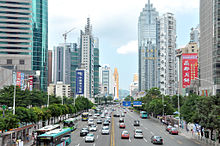
The economic reforms under Deng Xiaoping enabled the rapid development of coastal cities such as Shenzhen here.

Mao Zedong during the proclamation of the People's Republic of China on October 1, 1949 at the Gate of Heavenly Peace (right Dong Biwu)
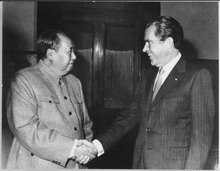
Meeting Mao Zedong with Richard Nixon 1972 in Beijing

Directly controlled territories of the Qing Empire at the time of its greatest expansion 1820

Cartoon in the August 23, 1899 Puck: "Uncle Sam" standing on a map of China being cut up by European heads of state, saying, "Gentleman, you can cut up this map as many times as you like, but remember that I, too, am here to stay."
Questions and Answers
Q: What is the People's Republic of China?
A: The People's Republic of China (PRC) is a one-party state in East Asia governed by the Chinese Communist Party (CCP). It was founded on 1 October 1949 and has more than 1.4 billion people, making it the most populous country in the world.
Q: How large is China?
A: China covers an area of 9.6 million square kilometers.
Q: What are the four municipalities directly controlled by the national government?
A: The four municipalities directly controlled by the national government are Beijing, Shanghai, Tianjin, and Chongqing.
Q: What are two special administrative regions (SARs)?
A: Two special administrative regions (SARs) are Hong Kong and Macau. These two cities remain highly autonomous or have much of their own power.
Q: How many provinces does PRC have?
A: PRC has 23 provinces and five "autonomous regions" or regions with more law-making rights than the provinces and with many people of a minority group population.
Q: What is PRC's stance on Taiwan?
A: PRC claims Taiwan as one of its many provinces but does not have control over it since it has an entirely different political system known as the Republic of China.
Search within the encyclopedia